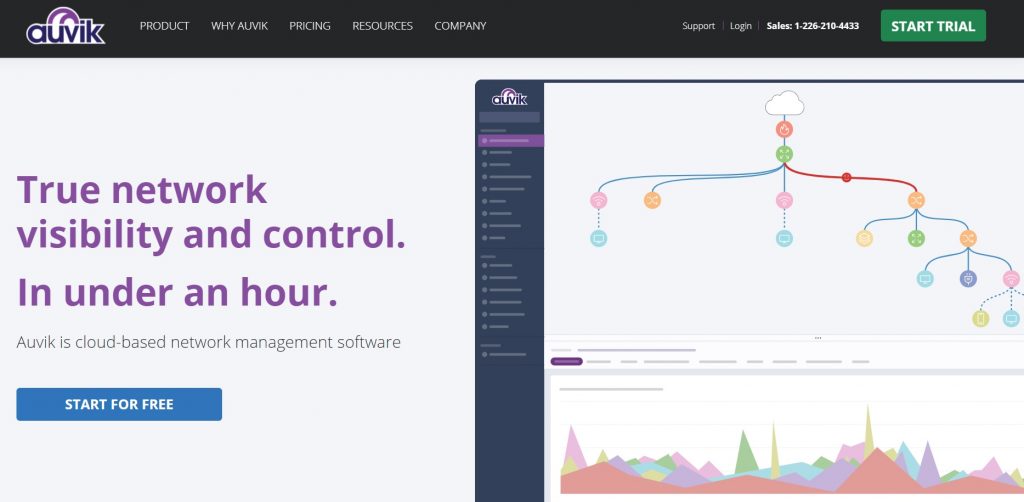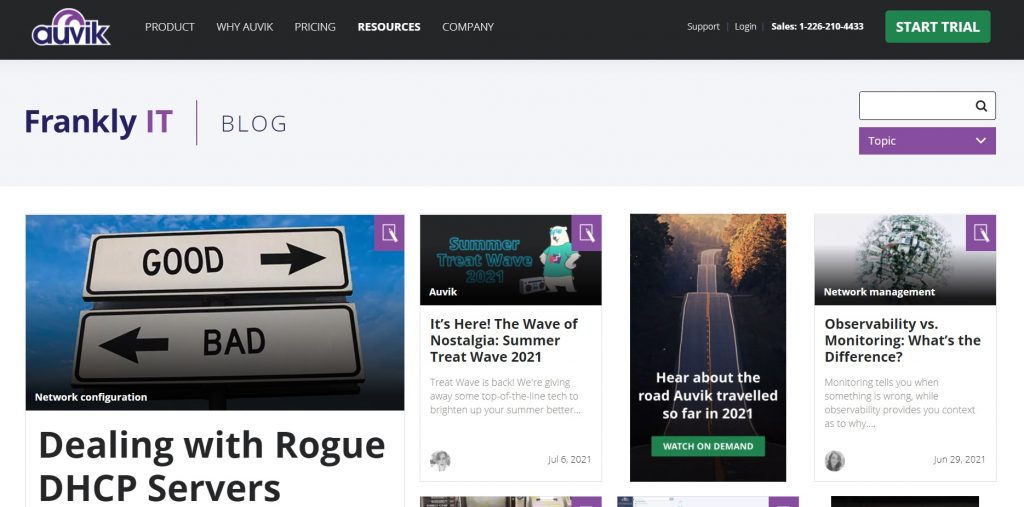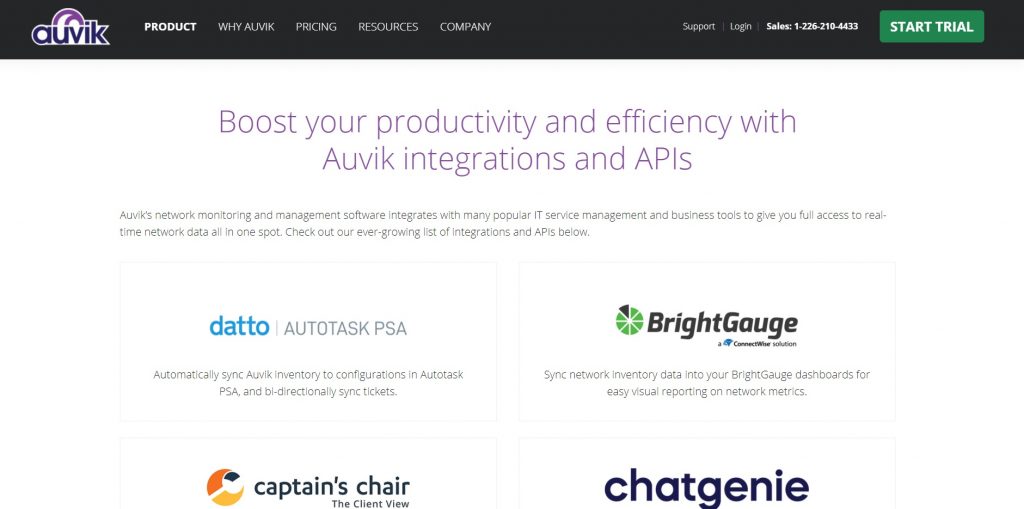Modern computer networks are characterized by high performance and complexity of structure. That’s why their manual control becomes not only inconvenient but also ineffective. To solve this problem, the RMM (Remote Monitoring and Management) software was developed.
Today, I’ll tell you about Auvik, one of the most efficient yet easy-to-use services for monitoring network performance automatically.
What is Auvik’s target audience?
Usually, there are SMB (small and medium business) owners.
What is Auvik?
It’s a cloud-based service that helps manage network infrastructure (switches, firewalls, routers, etc.).
Using Auvik, you can:
- detect network issues and troubleshoot them in real-time;
- connect network devices remotely;
- analyze the network performance;
- automate configuration recovery and many more.
Keep reading to find the answers to the questions, which will help you decide if it’s your cup of tea:
- How much does the service cost?
- What features does it offer?
- What are its pros and cons?
- What are the main Auvik competitors?
In-depth description
Main Auvik’s features
IT asset management and network visibility
The service completely automates the network discovery. You can always stay updated with the latest network performance data.

The service gets this information from Cisco Discovery Protocol, Link Layer Discovery Protocol, and forwarding tables to build the Layer 1 diagram of the network. As for the 2-nd and 3-rd Layers, they’re created using data from the Address Resolution Protocol tables, IP assignments, and VLAN associations.
The platform gathers information about every device that is connected to the network: their models, serial numbers, IP address, physical switch port.
Besides, you may identify the devices with expired support contracts or those, which need updating, etc.
Network performance monitoring
Auvik offers you more than 50 alerts (informational, emergency, etc.) that can be set up to monitor the network condition. Plus, you can customize them, add your own ones, and modify the frequency of the notifications.
The service constantly monitors the network: from the history of configurations to the performance of each device it includes. All collected data is added to the archive and stored for years.
Using Auvik’s dashboard, you can get access to all system logs from one place and see:
- how many VPN sessions are currently in use;
- if there is network congestion;
- detect dropped packets, etc.
Backup & recovery
The service checks the configuration of network devices every hour. In case of an error or a change in the network configuration, the system automatically backs up (all you need is to click on the “Restore” button).
Using Auvik, you may select the configuration of your network device from the history and explore which configuration elements were changed, modified, or deleted. The platform uses a color-coded system for this purpose.
Also, it’s possible to export settings and use them for any new network device. Detailed information about this feature can be found in Auvik’s documentation and blog.

Traffic analysis
Auvik helps you analyze which applications or protocols use the most of the bandwidth. This data can help you decide on upgrading or expanding the network.
You can easily figure out the source of the network spike by checking the source and destination addresses, conversations, ports, etc.
Also, the system shows the source of the traffic and data about the location of your users on an easy-to-read world map.
Network navigation
The service’s search feature provides you with a lot of filters (IP address, device name, MAC address, etc.), so you can quickly find a specific device or VLAN on the map. All alert indicators appear on the search field, so you can click on them to see the details.
On the map, you can see both physical and logical connections, their working status, media access control addresses, etc. All you have to do is hover over a wire to see details about the connection, its operational status, its MAC address, and the interfaces on each end.
Hover over a device to see the basic details like IP and status. Click on a device to bring up the device dashboard.
Site management
The management of multiple sites is one of the main purposes of this service.
If a company is distributed, it’s possible to see all network locations on the map, detect issues, and so on.
Due to a global alert and inventory view, it’s possible to control alerts from one place without the need to visit a specific website.
From the control panel, administrators can set the rules for accessing websites to specific users or groups of users, restrict roles, etc.
Pricing plans
The service offers a free trial. After expiration, you can choose between 2 pricing plans, but the cost is calculated individually.
| Essential plan | Performance plan | |
| Users | no limits | no limits |
| Network sites | no limits | no limits |
| Endpoints | no limits | no limits |
| Full customer support | no limits | no limits |
| Management of configurations | + | + |
| Global dashboard | + | + |
| Automated mapping and inventory | + | + |
| IP tracking by geolocation | – | + |
| Centralized SYSLOG management | – | + |
| Network flow tracking | – | + |
| Analytics | – | + |
Pros and cons
What I like:
- SNMP monitoring;
- a wide range of third-party services to integrate;
- high level of security (2FA, permission configurations, etc.).
What I don’t like:
- no free version;
- limited monitoring from mobile devices.
Auvik TOP-5 alternatives
Spectrum
Spectrum has the same target audience as Auvik does and works the same way: tracks metrics, creates logs, sets alerts, etc. However, the number of available features is fewer compared to Auvik. Plus, Spectrum is a pricier service (pricing plans start at $40,99).
Compared to Auvik, Spectrum allows users to contact experts by email and phone only (Auvik also supports tickets, webinars, live chat). Also, Spectrum enables you to use a full-fledged mobile version that makes it a handy software to work on the go.
Network Performance Monitor
The pricing plans of Network Performance Monitor start at €1,335 per license.
When it comes to functionality, Auvik offers more features than its competitor does (trace individual transactions, root-cause diagnosis, self-updating maps, etc.). It’s a cloud-based service, but also provides users with a mobile application for Android OS.
If you face technical issues, both services offer comprehensive knowledge bases and the ability to contact experts by email or using a chatbot. At the same time, Network Performance Monitor doesn’t allow you to call experts by phone as Auvik does.
AdRem NetCrunch
AdRem NetCrunch is also focused on SMBs. Like Auvik, it offers a free trial, but the cost of a subscription is pricier: $1,160 per year.
Compared to AdRem NetCrunch, Auvik can boast more features (hierarchical and on-demand mapping, device auto-discovery, asset tracking, etc.) and integrations (CloudRadial, DattoRMM, ConnectWise Automate, etc.).

This Auvik’s competitor doesn’t offer a mobile version and works only on Windows OS.
Splunk Cloud Platform
Splunk Cloud Platform is a completely SaaS product, while Auvik can be used on Windows or Mac OS. Splunk provides users with a free version, which is a significant advantage compared to Auvik.
On Splunk’s official website you can find an exhaustive knowledge base and constantly updated blog section. In case you need personalized help, you may contact Splunk’s experts by phone or send them an email.
As for network monitoring features, both services are almost the same (Auvik doesn’t come up with SLA monitoring). At the same time, Splunk doesn’t offer its users’ network mapping, MSP, and IT asset management features.
Panopta Advanced Monitoring
The target audience of Panopta Advanced Monitoring is managers and engineers who work with multi-server and cloud environments. Compared to Auvik, this service is cheaper and offers pricing plans starting from $9 per user for a month.
As for differences between network monitoring features, both services offer the same set of tools. However, Auvik can be integrated with more third-party services, while Panopta Advanced Monitoring offers only a few of them (Slack, Jira Software, PagerDuty).
Also, Panopta doesn’t come up with the same various customer support as Auvik’s does: experts are available not 24/7, but from 8 AM to 10 PM CDT. Moreover, there is no ability to call them by phone.
FAQ
Does Auvik collect anonymized info?
Yes, the service gathers anonymized metadata (the speed of the connection between devices, usage statistics, etc.), but it’s kept in a secured database.
What determines Auvik’s subscription price?
It depends on the number of monitored devices.
Are all network devices monitored for a fee?
No, such devices like workstations, access, or endpoints are monitored for free.
How long does Auvik keep statistics info?
It depends on the type of data. For example, information about backups is kept forever, while alerts are stored for 2 months.
What type of encryption does Auvik use?
The service uses a 256-bit long secure key to encrypt your data.
